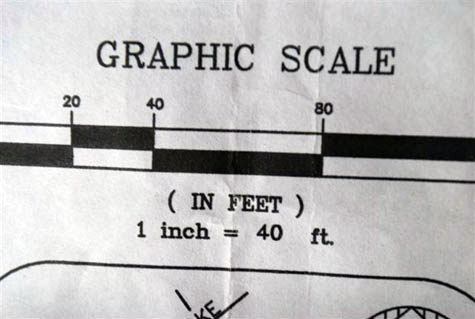Few things are harder than working at a proper scale. Constructing anything at the right scale-whether it be a landscape, a garden, a swath of groundcover, or a holiday window box, getting the project scaled properly is directly related to the level of confidence one feels taking on the project. What do I mean by this? A lack of confidence in one’s idea dimished the result. Confidence makes for properly scaled expressions. The size of a project needs to be properly proportioned to the size of a space.
What appears to be a giant size under construction in the garage gets visually downsized once it goes outdoors. They do not call it the great outdoors for nothing. Even my tiny urban property is bigger than any space or room I have inside my house. Add the sky to that property-outdoor spaces are big spaces. Groups of 1 or 3 tulips in a perennial garden is a tentative gesture. Planted in 9’s and 11’s, there may be a significant spring statement in the works.
A client ordered up a winter display in her second story window boxes. The iron boxes with their coir liners are enormous. Quite properly proportioned, or scaled, to the building. The boxes have liners that are but a tenth the size of the visible iron work. This is not a good proportion. I protested that I could not do make the winter displays large enough for the iron work, in 4 liners that were 8″ by 8″ by 6 inches deep. She asked me to try.
The four liners are not even visible here. We stuffed the four liners it took to fill one box with dry floral foam. Then we stuffed those liners with as much material as we could.
This picture shows the size of liner number 3, versus the overall size of the window box. What appeared so massive indoors got a visual dressing down at the installation. Inside these hayrack style window boxes-a plywood platform on which these small liners would sit.
A fall planting of cabbages and pansies is barely visible from the ground. Any display on the second floor, to be viewed from the ground, needs to be overscaled by 3 or 5 times. Our winter display to the right is barely big enough.
I was happy with the finished scale. Not that it could not have been bigger. This is my first try with these boxes. They read from the ground, but they could read better. Would that the greens could be thicker, and lower. The platinum twigs-are they too subtle? We installed these boxes this past Saturday-it was warm, and windless. A miraculously benign late November day.
The window boxes are a major architectural feature of this new house. I like the shape and the size. I was worried that I would underscale the winter display-as well I should have been. It is clear I could up size that display considerably, and be in no danger of overstating. It is hard to find just the right size and scale. Just think what it takes to find jeans and boots that fit right, and look right. The same applies to selecting the tree whose mature size will be the right scale for the space. Or the right number of Russian sage that will create visual excitement. Underscaled-this might make you sleepy. Somewhat overscaled-bold. Way overscaled-silliness. The right scale takes skill, nerve, and lots of patience.

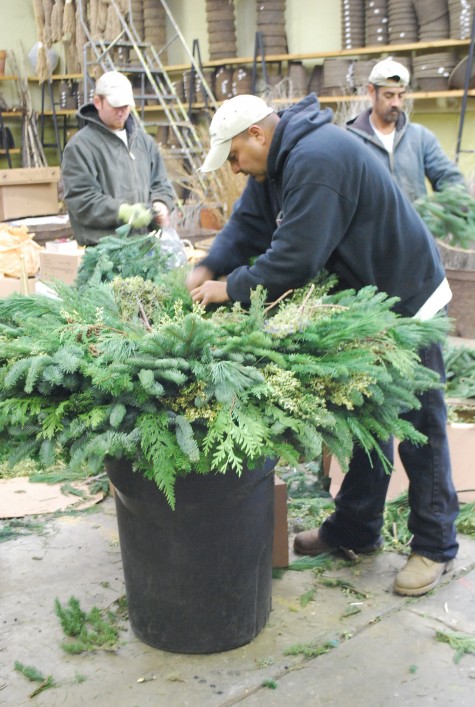

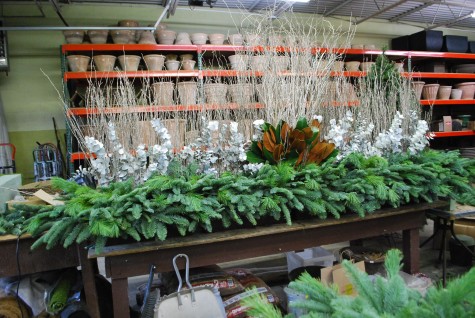
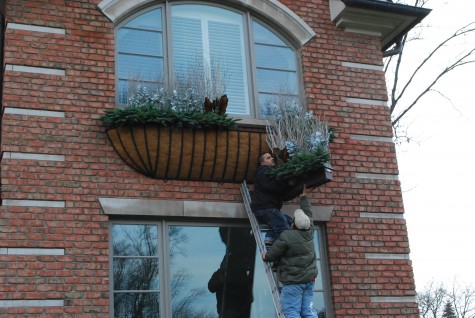

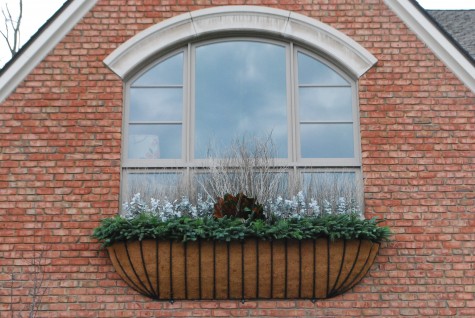
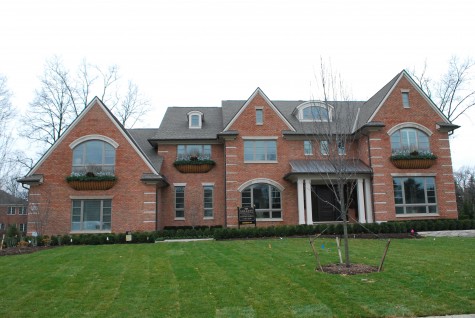
 If all the color of my past few posts has put you on overload, perhaps these pots will suit you better. As I have said, annual plants are those plants that survive but one season-this is a large group-some of which have no flowers of consequence.
If all the color of my past few posts has put you on overload, perhaps these pots will suit you better. As I have said, annual plants are those plants that survive but one season-this is a large group-some of which have no flowers of consequence. Annual plantings or pots without flowers can be very effective and attractive. Some locations for annuals do not have enough sun to support good flower production. Annual plants can be as much about their forms, their leaves, and their architecture, as they are about flowers. This very tall “elegant feather” plant-no longer in production at Proven Winners, is a great foil for the round-leaved farfugiums. There are very few greens I do not like. My yews go black green in the winter when it is really cold, much like this Moses in the Cradle. The chartreuse and yellow coleus “Wild Lime” provides lots of punch in shade.
Annual plantings or pots without flowers can be very effective and attractive. Some locations for annuals do not have enough sun to support good flower production. Annual plants can be as much about their forms, their leaves, and their architecture, as they are about flowers. This very tall “elegant feather” plant-no longer in production at Proven Winners, is a great foil for the round-leaved farfugiums. There are very few greens I do not like. My yews go black green in the winter when it is really cold, much like this Moses in the Cradle. The chartreuse and yellow coleus “Wild Lime” provides lots of punch in shade.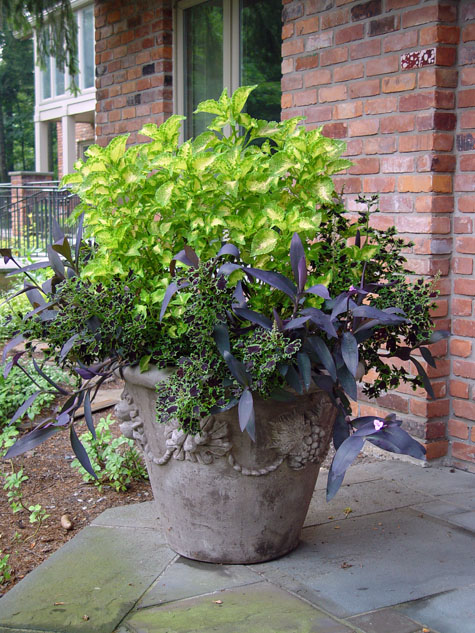 Chartreuse green is spring like, and fresh, no matter what time of year I see it.Grass after an electrical storm is so intensely dark gorgeous green-thus the term grass green. Lime creeping jenny is a versatile plant that highlights darker plants and obligingly trails.
Chartreuse green is spring like, and fresh, no matter what time of year I see it.Grass after an electrical storm is so intensely dark gorgeous green-thus the term grass green. Lime creeping jenny is a versatile plant that highlights darker plants and obligingly trails. 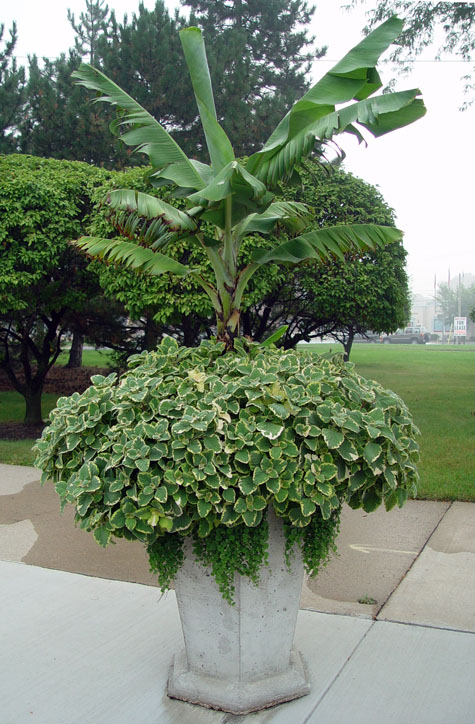 Green can be as much about texture and scale, as color. The slick, massive texture of this banana is complimented by the thick felted leaves of this variegated Plectranthus.
Green can be as much about texture and scale, as color. The slick, massive texture of this banana is complimented by the thick felted leaves of this variegated Plectranthus. Caladiums, calocasias, and cannas have spectacularly large foliage.
Caladiums, calocasias, and cannas have spectacularly large foliage. 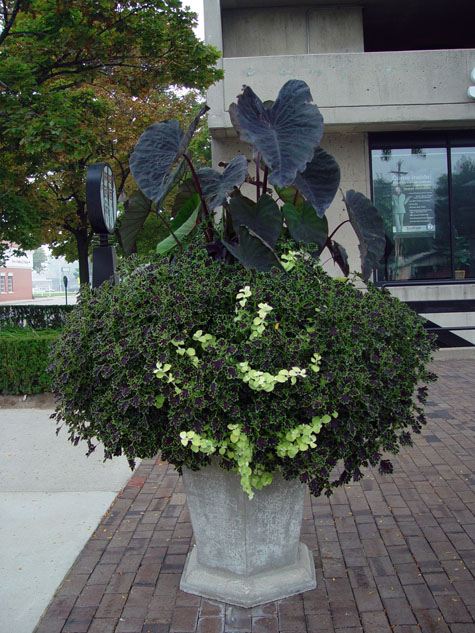 Calocasias and caladiums are thin-leaved (this refers to their “substance”); light will shine through them. Helicrysum both in lime and variegated leaf are densely felted.
Calocasias and caladiums are thin-leaved (this refers to their “substance”); light will shine through them. Helicrysum both in lime and variegated leaf are densely felted. 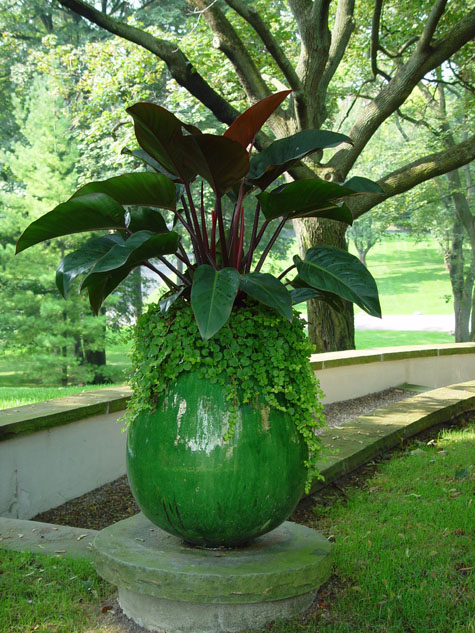
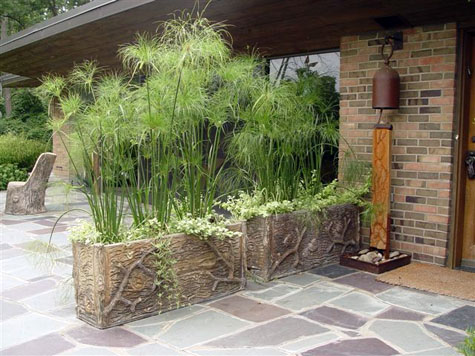
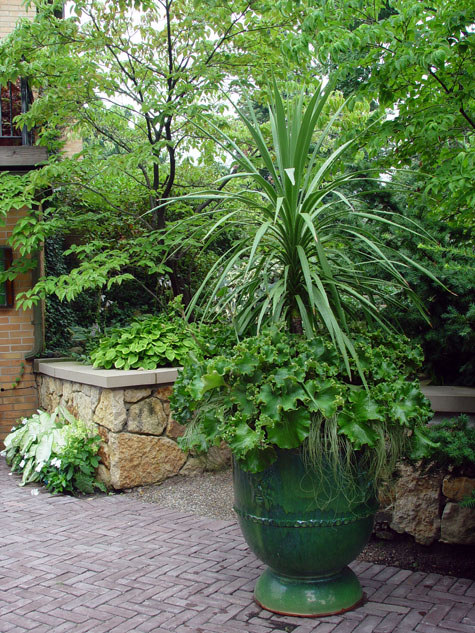 Phormiums, and dracaenas are stiff-strapped, and sword-like-an interesting contrast to this curly leaved farfugium. Cycads and escheverias have that dense waxy texture, and can be rounded, or spiky.
Phormiums, and dracaenas are stiff-strapped, and sword-like-an interesting contrast to this curly leaved farfugium. Cycads and escheverias have that dense waxy texture, and can be rounded, or spiky.
 Tuscan blue kale has great size, a blistered leaf surface, and a very blue color-just the thing to pair with a blue juniper column, variegated licorice, and ornamental oregano “Kent Beauty” .
Tuscan blue kale has great size, a blistered leaf surface, and a very blue color-just the thing to pair with a blue juniper column, variegated licorice, and ornamental oregano “Kent Beauty” .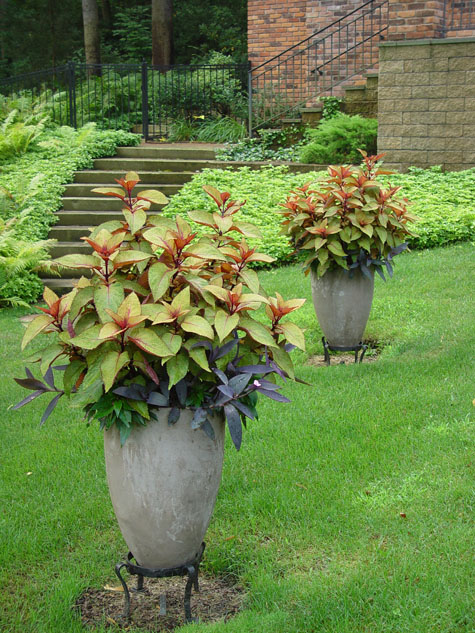 One of my favorite coleus is a yellow/olive color I call turtle green. The striped grass, miscanthus zebrina, is a happy companion to a plectranthus with the same color variation. The third element: the pairing of the plant material is complimented by the pairing of the pots close enough to encourage all the plectranthus to grow together.
One of my favorite coleus is a yellow/olive color I call turtle green. The striped grass, miscanthus zebrina, is a happy companion to a plectranthus with the same color variation. The third element: the pairing of the plant material is complimented by the pairing of the pots close enough to encourage all the plectranthus to grow together. So many beautiful greens. So many ways in which green is beautiful.
So many beautiful greens. So many ways in which green is beautiful. This is stage 3 of the schematic plan. By schematic, I mean a plan that details only the big gestures and spaces. It does not tell you which pots to buy, or which cultivar of daylily to plant. That comes later. The big decisions get made first. Where do I want my grill, and my terrace? Where can my kids play? Could I host a large party in that spot? Where do I need shade? Where can I plant my vegetables?
This is stage 3 of the schematic plan. By schematic, I mean a plan that details only the big gestures and spaces. It does not tell you which pots to buy, or which cultivar of daylily to plant. That comes later. The big decisions get made first. Where do I want my grill, and my terrace? Where can my kids play? Could I host a large party in that spot? Where do I need shade? Where can I plant my vegetables?